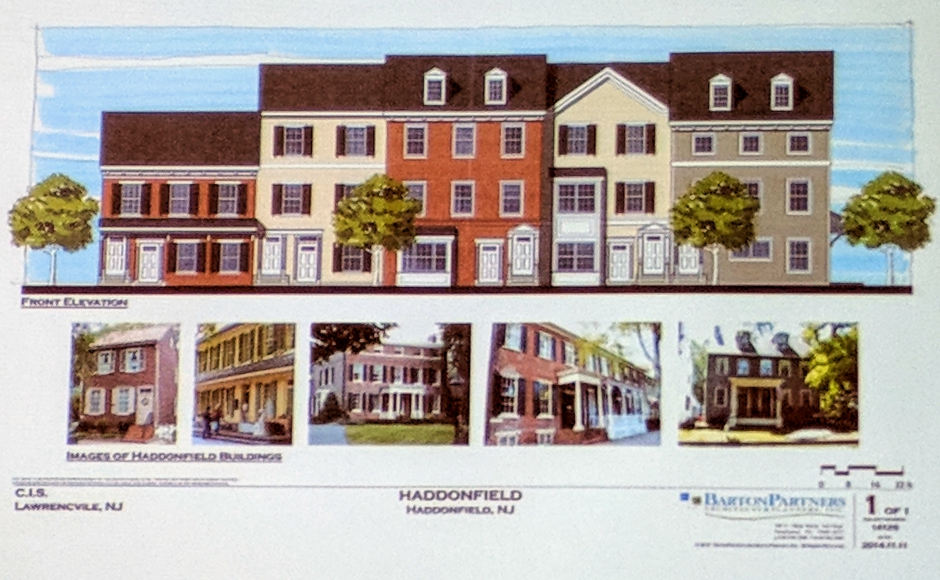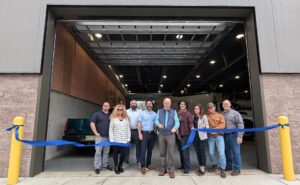The proposed build-out is the result of an affordable housing settlement agreement, and dates back to an agreement established a decade ago.

NJ Pen Local Government News is Proudly Presented by Fenza Legal Services. Click here to learn more.
By Matt Skoufalos | May 1, 2019
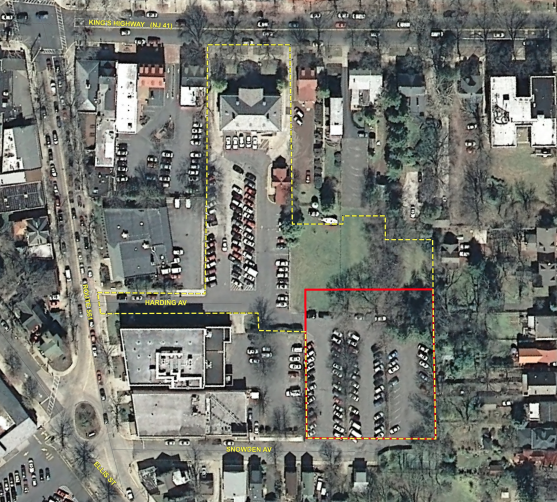
Proposed area of redevelopment in Haddonfield. The red-bordered area describes the potential location of Snowden Commons. Credit: Borough of Haddonfield.
In recent years, the biggest redevelopment story in Haddonfield has been the planned overhaul of the former Bancroft site on Kings Highway.
But on Tuesday, the borough offered a look at a project that’s been a decade in the works, yet is far lower-profile: a 28-unit, 100-percent affordable housing complex to be built on an acre-and-a-half of land behind borough hall.
Dubbed Snowden Commons for the tiny street (Snowden Avenue) on which it is to be situated, the project was first designated in 2008, when the state Council on Affordable Housing (COAH) issued its third round of rules on municipal affordable housing obligations.
It comes as part of a legal settlement over the availability of such housing in a borough where the median home value is around a half-million dollars.
Currently, Haddonfield has four affordable rental units in Kings Court, 20 in the Tarditi Commons on Lincoln Avenue, and 10 units are planned for the Bancroft redevelopment parcel. The 28 planned units in Snowden Commons would be the most allocated in any one section of town, and could add an estimated 14 school-aged children to the community.
Given the scarcity of available land in a town that’s mostly built out, Snowden Commons will provide 28 one-, two-, and three-bedroom rental units. Rents will range from $852 to $983 for a one-bedroom unit, from $1,022 to 1,180 for a two-bedroom unit, and from $1,181 to 1,363 for a three-bedroom unit.
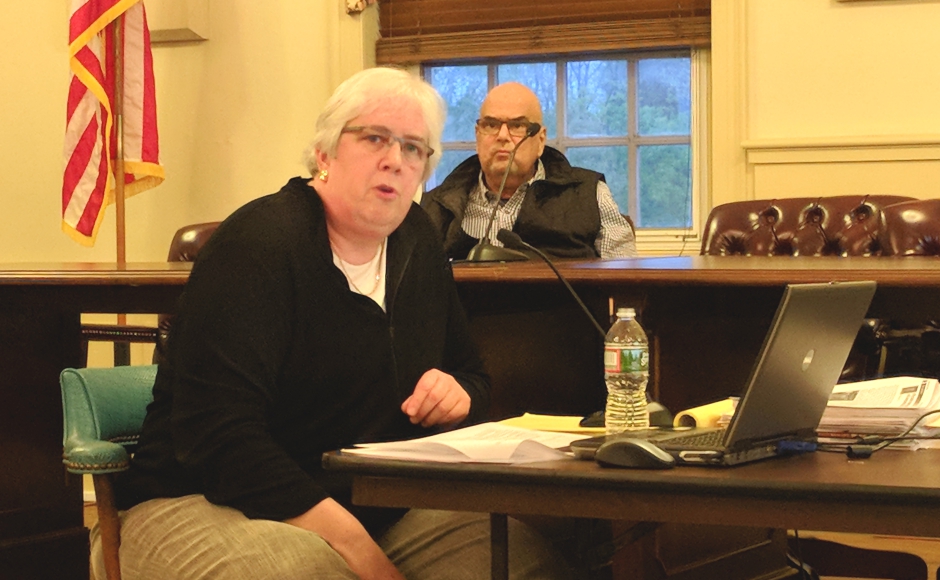
Planner Mary Beth Lonergan of Clarke Caton Hintz and Haddonfield Mayor Neal Rochford. Credit: Matt Skoufalos.
Four of the units will be designated for very low-income households (annual income of $18,354 to $26,220), 11 for low-income households ($30,590 to $43,700), and 13 for moderate-income households ($48,944 to $69,920).
“This housing is, generally speaking, for folks that are working,” said planner Mary Beth Lonergan of design firm Clarke Caton Hintz.
“It’s nursing assistants, municipal employees, folks just starting out, folks on a fixed income.
“The households usually have potentially just one wage-earner,” Lonergan said. “It could be a single-parent household, and they can’t afford a $2,500-per-month rent. They can afford average gross rent of these units.”
As proposed, Snowden Commons would be a three-story project “with a colonial feel,” Lonergan said; i.e., a brick and vinyl siding exterior that would match the architecture of the surrounding environment.
“It’s not going to be cookie-cutter, plain-vanilla affordable housing,” Lonergan said.
The project would still have to be rendered architecturally and approved by the borough planning and zoning boards. Procedurally, the next step in the process comes May 8, when Camden County Judge Nan S. Famular is slated to issue an opinion on the settlement agreement.
The borough will donate the one-and-a-half-acre parcel to its developer, Community Investment Strategies of Trenton, which will apply for federal and local subsidies to offset the cost of construction, Lonergan said.
“When a municipality decides to produce 100-percent affordable housing, the courts and COAH permit the developer to go after subsidies, including low-income tax credits, county HOME funds, state balance-housing funds and so forth,” Lonergan said.
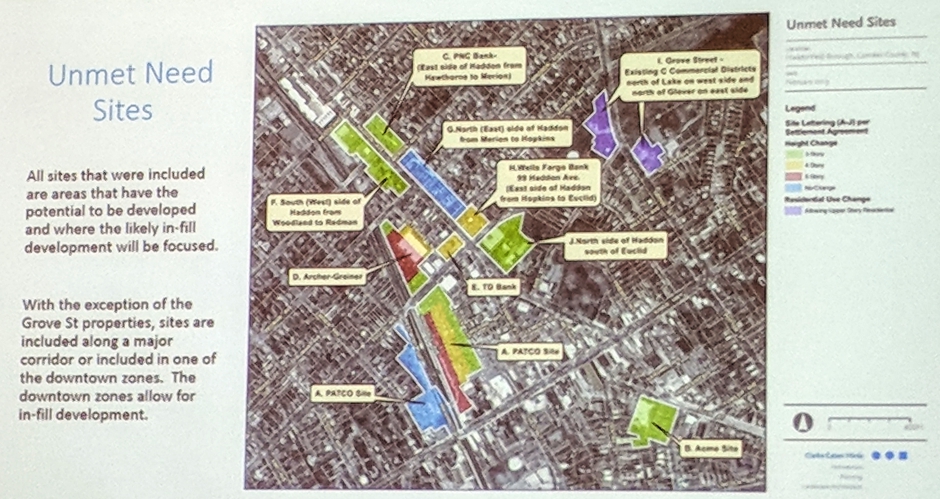
Potential areas of redevelopment in Haddonfield that could be used to address the borough’s unmet affordable housing needs. None is as yet headed for residential redevelopment. Credit: Borough of Haddonfield.
Part of the reason for the density of the project is that it’s not attached to any market-rate housing project to offset the cost of the affordable units the borough needs, Lonergan said.
“You’d need [to build] 140 total housing units to produce 28 affordable units,” she said. “There’s just not that type of land in the borough.”
In an information session held Tuesday, Haddonfield residents, many of them from nearby Potter Street, objected to the project.
“The way the plan is currently configured, those houses are basically in my backyard,” said Ian Miller. “Maybe you should remake that street into the same kind of street [Potter Street] has been remade into. A lot of those houses have been restored.
“Shoving it up in that corner takes away valuable green space, valuable parking space, and isolates that entire community,” Miller said. “I only ask, why do you have to plan it that way? I don’t really think for this area of town that it really fits in with the way the rest of these small streets are constructed.
“If you look at Tanner or Mechanic or Lake Street, there are plenty of small houses,” he said. “You could do an attractive job with that development, but not the way it is, shoved into the corner.”
Danielle McLaughlin objected to the construction of the project as isolating for low-income residents.
“I’m a very low-income single parent, and I would like to live in an apartment or house or whatever with my son,” McLaughlin said. “I love this town, my parents have worked hard to live here. I shouldn’t just have to live in a cookie-box section. This is not the way to do it.”
Haddonfield Commissioner Jeff Kasko said he understands concerns with the project, but noted that the agreement that established Snowden Commons was brokered a decade ago or longer.
“It’s not something new; it’s not something recent,” Kasko said. “This is the culmination of years of lawsuits. We’ve got to do the best thing under the circumstances.”
Acknowledging residents’ objections to the plan, the commissioner said the borough needs to address its affordable housing obligation under any circumstance.
“We have to do something,” he said. “Wherever we site it, there’s going to be some opposition. If the goal is we’ve got to have diverse housing stock, this is the kind of thing that has to happen.”
Haddonfield Mayor Neal Rochford said he is frustrated by the constraints of the law in a two-and-a-half square-mile community, but said the borough would be making the best of the situation.
“I hope that in the long run this will be beneficial to Haddonfield, and also to residents in the area of the Snowden lot,” Rochford said.

